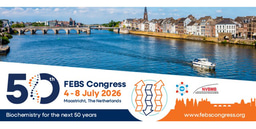
In this Special Issue, The FEBS Journal highlights a collection of recently published articles on COVID-19. These studies cover a variety of aspects related to COVID-19, ranging from the most recent improvements in therapies and the significant impact of the development of vaccines, to the emergence of variants of SARS-CoV-2, the role of the immune system in the various stages of the disease and the impact of the disease in different organs. We encourage you to consult the editorial [1] by our Editorial Board member Lawrence Banks and co-authors for an informative overview of the issue’s articles.
In the interview included in the issue [2], two leading experts in vaccinology and immunology discuss the different vaccine platforms which have been developed against COVID-19, the nature of the immune response they induce, and the length of protection they are likely to offer.
The review by Seyran et al. [3] focuses on the structure of S protein and how it enables the attachment and entry of the virus in the host cell. Notably, Lin et al. [4] report that a subtype of tubular cells is the most vulnerable cell type to SARS-CoV-2 infection in the kidney.
The studies by Ku et al. [5] and Tong et al. [6] discuss how modulation of inflammation can improve the disease outcome and the role of T-cell immunity in diabetic patients upon SARS-CoV-2 infection, respectively. Importantly, the role of inflammation in end-stage COVID-19 is also emphasised by Zeng et al. [7].
Therapeutic approaches targeting specific factors of the virus have been considered; on this note, 3C-like cysteine proteases and the nsp14/nsp10 complex are discussed as potential targets of novel therapies against COVID-19 by Chen et al. [8] and Saramago et al. [9], respectively. Similarly, Caillet-Saguy et al. [10] focus on PBM-PDZ interactions as possible targets of novel anti-viral therapeutics. Moreover, Hari Prasad [11] reviews the role of endosomal acidification in SARS-CoV-2 infection and explores the potential of alkalinizing drugs as therapies for COVID-19.
Remarkably, Mok et al. review the ageing immune response as a risk factor for severe disease [12] and Merzon et al. investigate the potential protective role of aspirin on infection [13].
We invite you to also browse the remaining of the issue’s articles, which provide insights into various aspects of COVID-19 disease.
We hope that our readers will find the issue’s content timely and informative. Many thanks to all the authors for their excellent contributions to this Special Issue on COVID-19.
Cover Information: The cover artwork entitled 'Different approaches to Covid-19 vaccine development' was provided by Merve Evren, from Izmir in Turkey. Merve contributed the winning image for a Cover Image Competition run by The FEBS Journal in 2021.
References:
- Zacchigna S, Marcello A, Banks L (2021) Spotlight on COVID-19: eighteen months on. FEBS J. 288, 4992-4995.
- Dhillon P, Altmann D & Male V (2021) COVID-19 vaccines: what do we know so far? FEBS J. 288, 4996-5009.
- Seyran M, Takayama K, Uversky VN, Lundstrom K, Palù G, Sherchan SP, Attrish D, Rezaei N, Aljabali AAA, Ghosh S et al. (2020) The Structural Basis of Accelerated Host Cell Entry by SARS-CoV-2. FEBS J. 288, 5010-5020.
- Lin H, Ma X, Xiao F, Su H, Shi Y, Liu Y, Song L, Zhang Z, Zhang C & Peng H (2021) Identification of a special cell type as a determinant of the kidney tropism of SARS-CoV-2. FEBS J. 288, 5163-5178.
- Ku CL, Chen IT & Lai MZ (2021) Infection-induced inflammation from specific inborn errors of immunity to COVID-19. FEBS J. 288, 5021-5041.
- Tong ZWM, Grant E, Gras S, Wu M, Smith C, Barrett HL, Gallo LA &, Short KR (2021) The role of T-cell immunity in COVID-19 severity amongst people living with type II diabetes. FEBS J. 288, 5042-5054.
- Zeng HL, Chen D, Yan J, Yang Q, Han QQ, Li SS & Cheng L (2020) Proteomic characteristics of bronchoalveolar lavage fluid in critical COVID-19 patients. FEBS J. 288, 5190-5200.
- Chen CC, Yu X, Kuo CJ, Min J, Chen S, Ma L, Liu K & Guo RT (2021) Overview of antiviral drug candidates targeting coronaviral 3C-like main proteases. FEBS J. 288, 5089-5121.
- Saramago M, Bárria C, Costa VG, Souza CS, Viegas SC, Domingues S, Lousa D, Soares CM, Arraiano CM & Matos RG (2021) New targets for drug design: importance of nsp14/nsp10 complex formation for the 3’-5’ exoribonucleolytic activity on SARS-CoV-2. FEBS J. 288, 5130-5147.
- Caillet-Saguy C, Durbesson F, Rezelj VV, Gogl G, Tran QD, Twizere JC, Vignuzzi M, Vincentelli R & Wolff N (2021) Host PDZ-containing proteins targeted by SARS-CoV-2. FEBS J. FEBS J. 288, 5148-5162.
- Prasad H (2021) Protons to patients: targeting endosomal Na+/H+ exchangers against COVID-19 and other viral diseases. FEBS J. 288, 5071-5098.
- Mok, D.Z.L., Chan, C.Y.Y., Ooi, E.E. and Chan, K.R. (2020), The effects of aging on host resistance and disease tolerance to SARS-CoV-2 infection. FEBS J. 288, 5055-5070.
- Merzon, E., Green, I., Vinker, S., Golan-Cohen, A., Gorohovski, A., Avramovich, E., Frenkel-Morgenstern, M. and Magen, E. (2021), The use of aspirin for primary prevention of cardiovascular disease is associated with a lower likelihood of COVID-19 infection. FEBS J. 288, 5179-5189.





Join the FEBS Network today
Joining the FEBS Network’s molecular life sciences community enables you to access special content on the site, present your profile, 'follow' contributors, 'comment' on and 'like' content, post your own content, and set up a tailored email digest for updates.